3xLOGIC VISIX Camera User Manual
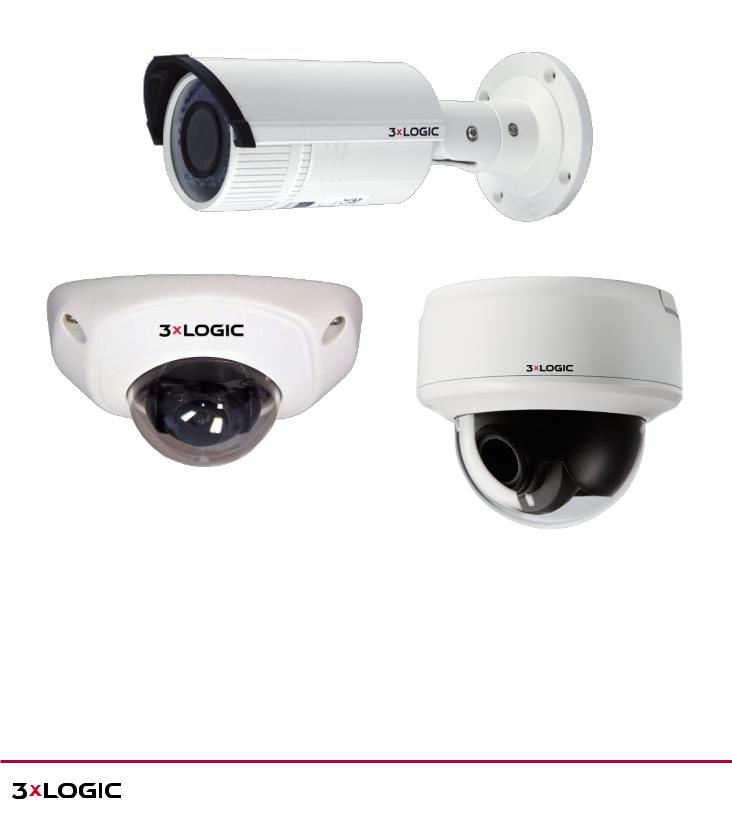
User Manual| VISIX Network Camera
VISIX Network Camera
User Manual
V5.1
10225 Westmoor Drive, Suite 300, Westminster, CO 80021 | www.3xlogic.com | (877) 3XLOGIC |
1 |

This manual is applied to the following camera models:
Camera Type
Box camera
Dome camera
•VSX-2MP-FE
•VSX-2MP-D2-RF
•VSX-3MP-ODIR28
•VSX-3MP-D2RF- WDR
•VSX-5MP-D2-RF
•VSX-2MP-OD2-IRFH
•VSX-2MP-MVD28
•VSX-2MP-MVD
•VSX-2MP-MVD40
|
• |
VSX-2MP-MBIR |
|
Bullet Camera |
• VSX-2MP-BIR-RF |
||
• |
VSX-3MP-BIR-RF |
||
|
|||
Cube Cameras |
• |
VSX-1.3MP-PIR1 |
|
User Manual| VISIX Network Camera
Model
• VX-3M-F-AWD
•VX-3P4-MD-I
•VX-3P28-OD-I
•VX-3P28-MD-I
•VX-3P28-MD-IA
•VX-3P28-MD-IAWI
•VX-2M-OD2-RIAH
•VX-3M-OD2-RIAWD
•VX-2M-D2-RIA
•VX-3M-D2-RIAWD
•VX-5M-D2-RA
•VX-3PV-B-I
•VX-3M-B-RIAWD
•VX-2M-B-RIA
•VX-3P28-MB-I
•VX-3P4-MB-I
The VSX line of cameras has been discontinued. Although the majority of this manual will be accurate in Note: regards to VSX-line cameras, some inaccuracies may exist due to features being added in firmware
versions released after the discontinuation of the VSX line. Please contact your 3xLOGIC support representative for more info.
Thank you for purchasing our product. If there are any questions, or requests, please do not hesitate to contact the dealer.
This manual may contain technical inaccuracies or printing errors. The content is subject to change without notice. The manual will be amended if there are any hardware updates or changes.
DISCLAIMER STATEMENT
“Underwriters Laboratories Inc. (“UL”) has not tested the performance or reliability of the security or signaling aspects of this product. UL has only tested for fire, shock or casualty hazards as outlined in UL’s Standard(s) for Safety, UL60950-1. UL Certification does not cover the performance or reliability of the security or signaling aspects of this product. UL MAKES NO REPRESENTATIONS, WARRANTIES OR CERTIFICATIONS WHATSOEVER REGARDING THE PERFORMANCE OR RELIABILITY OF ANY SECURITY OR SIGNALING RELATED FUNCTIONS OF THIS PRODUCT.”
10225 Westmoor Drive, Suite 300, Westminster, CO 80021 | www.3xlogic.com | (877) 3XLOGIC |
2 |

User Manual| VISIX Network Camera
Regulatory Information
FCC Information
FCC compliance: This equipment has been tested and found to comply with the limits for a digital device, pursuant to part 15 of the FCC Rules. These limits are designed to provide reasonable protection against harmful interference when the equipment is operated in a commercial environment. This equipment generates, uses, and can radiate radio frequency energy and, if not installed and used in accordance with the instruction manual, may cause harmful interference to radio communications. Operation of this equipment in a residential area is likely to cause harmful interference in which case the user will be required to correct the interference at his own expense.
FCC Conditions
This device complies with part 15 of the FCC Rules. Operation is subject to the following two conditions:
1.This device may not cause harmful interference.
2.This device must accept any interference received, including interference that may cause undesired operation.
EU Conformity Statement
This product and - if applicable - the supplied accessories too are marked with "CE" and comply therefore with the applicable harmonized European standards listed under the Low Voltage Directive 2006/95/EC, the EMC Directive 2004/108/EC, the RoHS Directive 2011/65/EU.
2012/19/EU (WEEE directive): Products marked with this symbol cannot be disposed of as unsorted municipal waste in the European Union. For proper recycling, return this product to your local supplier upon the purchase of equivalent new equipment, or dispose of it at designated collection points. For more information see: www.recyclethis.info.
2006/66/EC (battery directive): This product contains a battery that cannot be disposed of as unsorted municipal waste in the European Union. See the product documentation for specific battery information. The battery is marked with this symbol, which may include lettering to indicate cadmium (Cd), lead (Pb), or mercury (Hg). For proper recycling, return the battery to your supplier or to a designated collection point. For more information see: www.recyclethis.info
10225 Westmoor Drive, Suite 300, Westminster, CO 80021 | www.3xlogic.com | (877) 3XLOGIC |
3 |
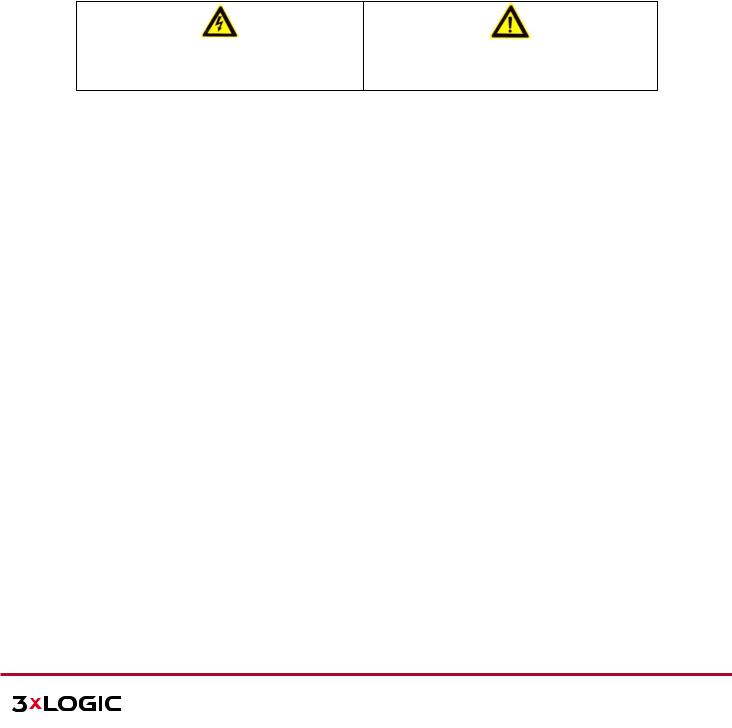
User Manual| VISIX Network Camera
Safety Instruction
These instructions are intended to ensure that the user can use the product correctly to avoid danger or property loss.
The precaution measure is divided into ‘Warnings’ and ‘Cautions’:
Warnings: Serious injury or death may be caused if any of these warnings are neglected.
Cautions: Injury or equipment damage may be caused if any of these cautions are neglected.
Warnings Follow these safeguards to prevent serious injury or death.
 Warnings:
Warnings:
Cautions Follow these precautions to prevent potential injury or material damage.
!Please adopt the power adapter which can meet the safety extra low voltage (SELV) standard. And source with 12 VDC or 24 VAC (depending on models) according to the IEC60950-1 and Limited Power Source standard.
!If the product does not work properly, please contact your dealer or the nearest service center. Never attempt to disassemble the camera yourself. (We shall not assume any responsibility for problems caused by unauthorized repair or maintenance.)
!To reduce the risk of fire or electrical shock, do not expose this product to rain or moisture.
!This installation should be made by a qualified service person and should conform to all the local codes.
!Please install blackouts equipment into the power supply circuit for convenient supply interruption.
!Please make sure that the ceiling can support more than 50(N) Newton gravities if the camera is fixed to the ceiling.
!If the product does not work properly, please contact your dealer or the nearest service center. Never attempt to disassemble the camera yourself. (We shall not assume any responsibility for problems caused by unauthorized repair or maintenance.)
10225 Westmoor Drive, Suite 300, Westminster, CO 80021 | www.3xlogic.com | (877) 3XLOGIC |
4 |

User Manual| VISIX Network Camera
 Cautions:
Cautions:
!Make sure the power supply voltage is correct before using the camera.
!Do not drop the camera or subject it to physical shock.
!Do not touch sensor modules with fingers. If cleaning is necessary, use a clean cloth with a bit of ethanol and wipe it gently. If the camera will not be used for an extended period of time, put on the lens cap to protect the sensor from dirt.
!Do not aim the camera lens at the strong light such as sun or incandescent lamp. The strong light can cause fatal damage to the camera.
!The sensor may be burned out by a laser beam, so when any laser equipment is being used, make sure that the surface of the sensor not be exposed to the laser beam.
!Do not place the camera in extremely hot, cold temperatures (the operating temperature should be between - 30°C ~ 60°C, or -40°C ~ 60°C if the camera model has an “H” in its suffix), dusty or damp environment, and do not expose it to high electromagnetic radiation.
!To avoid heat accumulation, good ventilation is required for a proper operating environment.
!Keep the camera away from water and any liquid.
!While shipping, the camera should be packed in its original packing.
!Improper use or replacement of the battery may result in hazard of explosion. Please use the manufacturer recommended battery type.
For cameras that support IR, you are required to pay attention to the following precautions to prevent Note: IR reflection.
!Dust or grease on the dome cover will cause IR reflection. Please do not remove the dome cover film until the installation is finished. If there is dust or grease on the dome cover, clean the dome cover with clean soft cloth and isopropyl alcohol.
!Make certain the installation location does not have reflective surfaces of objects too close to the camera. The IR light from the camera may reflect back into the lens causing reflection.
!The foam ring around the lens must be seated flush against the inner surface of the bubble to isolate the lens from the IR LEDS. Fasten the dome cover to camera body so that the foam ring and the dome cover are attached seamlessly.
10225 Westmoor Drive, Suite 300, Westminster, CO 80021 | www.3xlogic.com | (877) 3XLOGIC |
5 |

User Manual| VISIX Network Camera |
|
Table of Contents |
|
1 SYSTEM REQUIREMENTS................................................................................................................................... |
9 |
2 NETWORK CONNECTION................................................................................................................................. |
10 |
2.1 SETTING THE NETWORK CAMERA OVER THE LAN.......................................................................................................... |
10 |
Wiring over the LAN ............................................................................................................................................ |
10 |
Detecting and Changing the IP Address .............................................................................................................. |
11 |
2.2 SETTING THE NETWORK CAMERA OVER THE WAN........................................................................................................ |
13 |
Static IP Connection............................................................................................................................................. |
13 |
Dynamic IP Connection........................................................................................................................................ |
14 |
3 ACCESS TO THE NETWORK CAMERA................................................................................................................ |
16 |
3.1 ACCESSING BY WEB BROWSERS................................................................................................................................. |
16 |
4 WI-FI SETTINGS............................................................................................................................................... |
18 |
4.1 CONFIGURING WI-FI CONNECTION IN MANAGE AND AD-HOC MODES.............................................................................. |
18 |
Security Mode Description:.................................................................................................................................. |
19 |
4.2 EASY WI-FI CONNECTION WITH WPS FUNCTION .......................................................................................................... |
21 |
4.3 IP PROPERTY SETTINGS FOR WIRELESS NETWORK CONNECTION ...................................................................................... |
23 |
5 CHAPTER 5 LIVE VIEW ..................................................................................................................................... |
25 |
5.1 LIVE VIEW PAGE..................................................................................................................................................... |
25 |
5.2 STARTING LIVE VIEW ............................................................................................................................................... |
26 |
5.3 RECORDING AND CAPTURING PICTURES MANUALLY ...................................................................................................... |
26 |
5.4 OPERATING PTZ CONTROL ....................................................................................................................................... |
26 |
PTZ Control Panel ................................................................................................................................................ |
26 |
Setting / Calling a Preset ..................................................................................................................................... |
27 |
6 NETWORK CAMERA CONFIGURATION............................................................................................................. |
29 |
6.1 CONFIGURING LOCAL PARAMETERS............................................................................................................................ |
29 |
6.2 CONFIGURING TIME SETTINGS................................................................................................................................... |
30 |
6.3 CONFIGURING NETWORK SETTINGS............................................................................................................................ |
31 |
Configuring TCP/IP Settings................................................................................................................................. |
31 |
Configuring Port Settings..................................................................................................................................... |
32 |
Configuring PPPoE Settings ................................................................................................................................. |
33 |
Configuring DDNS Settings .................................................................................................................................. |
33 |
Configuring SNMP Settings.................................................................................................................................. |
36 |
Configuring 802.1X Settings ................................................................................................................................ |
37 |
Configuring QoS Settings..................................................................................................................................... |
38 |
Configuring UPnP™ Settings................................................................................................................................ |
38 |
Email Sending Triggered by Alarm ...................................................................................................................... |
39 |
10225 Westmoor Drive, Suite 300, Westminster, CO 80021 | www.3xlogic.com | (877) 3XLOGIC |
6 |

User Manual| VISIX Network Camera |
|
Configuring NAT (Network Address Translation) Settings................................................................................... |
40 |
Configuring FTP Settings...................................................................................................................................... |
41 |
6.4 CONFIGURING VIDEO AND AUDIO SETTINGS ................................................................................................................ |
42 |
Configuring Video Settings .................................................................................................................................. |
42 |
Configuring Audio Settings .................................................................................................................................. |
43 |
Configuring ROI Encoding.................................................................................................................................... |
43 |
6.5 CONFIGURING IMAGE PARAMETERS ........................................................................................................................... |
45 |
Configuring Display Settings................................................................................................................................ |
45 |
Configuring OSD Settings..................................................................................................................................... |
48 |
Configuring Text Overlay Settings ....................................................................................................................... |
49 |
Configuring Privacy Mask .................................................................................................................................... |
50 |
Configuring Picture Overlay................................................................................................................................. |
50 |
6.6 CONFIGURING AND HANDLING ALARMS ...................................................................................................................... |
51 |
Configuring Motion Detection ............................................................................................................................. |
51 |
Configuring Video Tampering Alarm ................................................................................................................... |
55 |
Configuring Alarm Input ...................................................................................................................................... |
56 |
Configuring Alarm Output ................................................................................................................................... |
57 |
Handling Exception.............................................................................................................................................. |
58 |
Configuring Face Detection ................................................................................................................................. |
58 |
Configuring Audio Exception Detection ............................................................................................................... |
59 |
Configuring Intrusion Detection .......................................................................................................................... |
60 |
Configuring Defocus Detection ............................................................................................................................ |
61 |
Configuring Scene Change Detection .................................................................................................................. |
61 |
7 STORAGE SETTINGS ........................................................................................................................................ |
63 |
7.1 CONFIGURING NAS SETTINGS ................................................................................................................................... |
63 |
7.2 CONFIGURING RECORDING SCHEDULE ........................................................................................................................ |
64 |
7.3 CONFIGURING SNAPSHOT SETTINGS ........................................................................................................................... |
67 |
8 PLAYBACK....................................................................................................................................................... |
69 |
9 LOG SEARCHING ............................................................................................................................................. |
71 |
10 OTHERS ........................................................................................................................................................ |
72 |
10.1 MANAGING USER ACCOUNTS ................................................................................................................................. |
72 |
Add a User ........................................................................................................................................................... |
72 |
Modify a User ...................................................................................................................................................... |
72 |
Delete a User ....................................................................................................................................................... |
73 |
10.2 CONFIGURING RTSP AUTHENTICATION..................................................................................................................... |
73 |
10.3 ANONYMOUS VISIT ............................................................................................................................................... |
74 |
10.4 IP ADDRESS FILTER ............................................................................................................................................... |
75 |
10.5 VIEWING DEVICE INFORMATION .............................................................................................................................. |
76 |
10.6 MAINTENANCE..................................................................................................................................................... |
76 |
10225 Westmoor Drive, Suite 300, Westminster, CO 80021 | www.3xlogic.com | (877) 3XLOGIC |
7 |

|
User Manual| VISIX Network Camera |
Rebooting the Camera......................................................................................................................................... |
76 |
Restoring Default Settings................................................................................................................................... |
77 |
Exporting / Importing Configuration File............................................................................................................. |
77 |
Upgrading the System ......................................................................................................................................... |
77 |
10.7 RS-232 SETTINGS ................................................................................................................................................ |
78 |
10.8 RS-485 SETTINGS ................................................................................................................................................ |
79 |
10225 Westmoor Drive, Suite 300, Westminster, CO 80021 | www.3xlogic.com | (877) 3XLOGIC |
8 |

User Manual| VISIX Network Camera
1 System Requirements
Operating System: Microsoft Windows XP SP1 and above version / Vista / Win7 / Server 2003 / Server 2008 32bits
CPU: Intel Pentium IV 3.0 GHz or higher
RAM: 1G or higher
Display: 1024×768 resolution or higher
Web Browser: Internet Explorer 6.0 and above version, Safari 5.02 and above version, Mozilla Firefox 3.5 and above version and Google Chrome8 and above versions.
10225 Westmoor Drive, Suite 300, Westminster, CO 80021 | www.3xlogic.com | (877) 3XLOGIC |
9 |
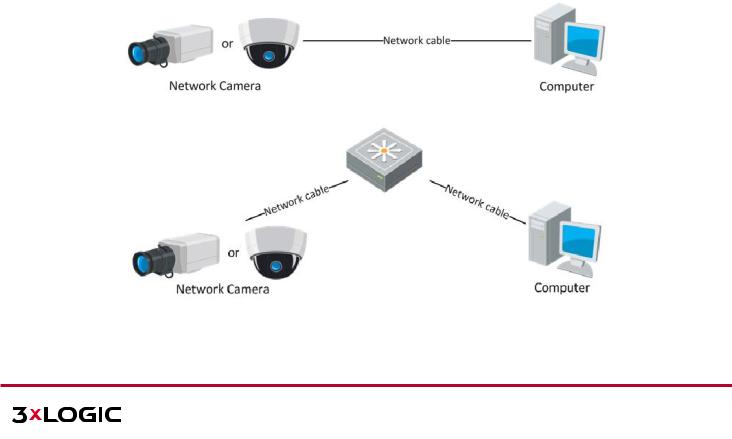
User Manual| VISIX Network Camera
2 Network Connection
Before you start:
!If you want to set the network camera via a LAN (Local Area Network), please refer to Section 2.1 Setting the Network Camera over the LAN.
!If you want to set the network camera via a WAN (Wide Area Network), please refer to Section 2.2 Setting the Network Camera over the WAN.
2.1 Setting the Network Camera over the LAN
Purpose:
To view and configure the camera via a LAN, you need to connect the network camera in the same subnet with your computer, and install the 3xLOGIC VISIX detection software. This will allow you to search and change the IP address of the detected network cameras.
For the detailed introduction of the 3xLOGIC VISIX camera detection software, please refer to this link: Note: http://www.3xlogic.com/3xdocuments/kb-article/130005-1-guide-visix-setup-utility-guide
WIRING OVER THE LAN
The following figures show the two methods of cable connection between a network camera and a computer:
Purpose:
!To test the network camera, you can directly connect the network camera to the computer with a network cable as shown in Figure 2-1.
!Refer to the Figure 2-2 to set network camera over the LAN via a switch or a router.
Figure 2-1 Connecting Directly
Figure 2-2 Connecting via a Switch or a Router
10225 Westmoor Drive, Suite 300, Westminster, CO 80021 | www.3xlogic.com | (877) 3XLOGIC |
10 |
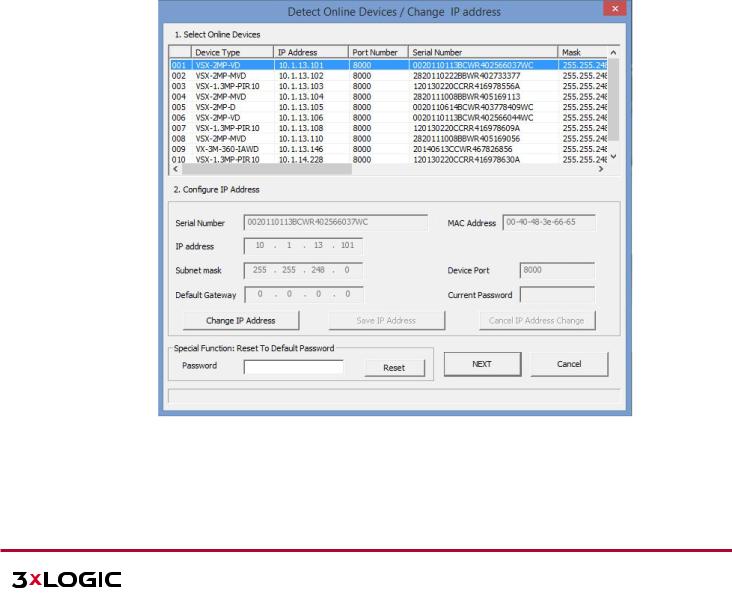
User Manual| VISIX Network Camera
DETECTING AND CHANGING THE IP ADDRESS
You need the camera IP address to connect to the network camera.
Steps:
1)To get the IP address, the 3xLOGIC VISIX setup utility, a software tool which can automatically detect the online network cameras in the LAN and list the device information including IP address, subnet mask, port number, device serial number, device version, etc., shown in Figure 2-3.
2)Change the IP address and subnet mask to the same subnet as that of your computer.
3)Enter the IP address of network camera in the address field of the web browser to view the live video.
Note: ! The default IP address is 192.0.0.64 and the port number is 8000. The default user name is admin, and password is 12345.
!For accessing the network camera from different subnets, please set the gateway for the network camera after you logged in. For detailed information, please refer to Section 5.3.1
Configuring TCP/IP Settings.
Figure 2-3 : 3xLOGIC VISIX detection utility
10225 Westmoor Drive, Suite 300, Westminster, CO 80021 | www.3xlogic.com | (877) 3XLOGIC |
11 |

User Manual| VISIX Network Camera
10225 Westmoor Drive, Suite 300, Westminster, CO 80021 | www.3xlogic.com | (877) 3XLOGIC |
12 |
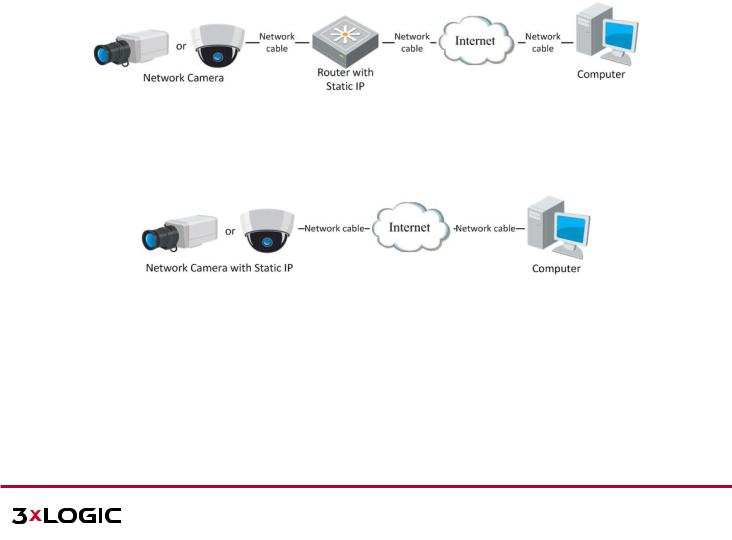
User Manual| VISIX Network Camera
2.2 Setting the Network Camera over the WAN
Purpose:
This section explains how to connect the network camera to the WAN with a static IP or a dynamic IP.
STATIC IP CONNECTION
Before you start:
Please apply a static IP from an ISP (Internet Service Provider). With the static IP address, you can connect the network camera via a router or connect it to the WAN directly.
Connecting the network camera via a router
Steps:
1)Connect the network camera to the router.
2)Assign a LAN IP address, the subnet mask and the gateway. Refer to Section 2.1.2 Detecting and Changing the IP Address for detailed IP address configuration of the camera.
3)Save the static IP in the router.
4)Set port mapping, e.g., 80, 8000, and 554 ports. The steps for port mapping vary according to the different routers. Please call the router manufacturer for assistance with port mapping.
5)Visit the network camera through a web browser or the client software over the internet.
Figure 2-4 Accessing the Camera through Router with Static IP
Connecting the network camera with static IP directly
You can also save the static IP in the camera and directly connect it to the internet without using a router. Refer to Section 2.1.2 Detecting and Changing the IP Address for detailed IP address configuration of the camera.
Figure 2-5 Accessing the Camera with Static IP Directly
10225 Westmoor Drive, Suite 300, Westminster, CO 80021 | www.3xlogic.com | (877) 3XLOGIC |
13 |
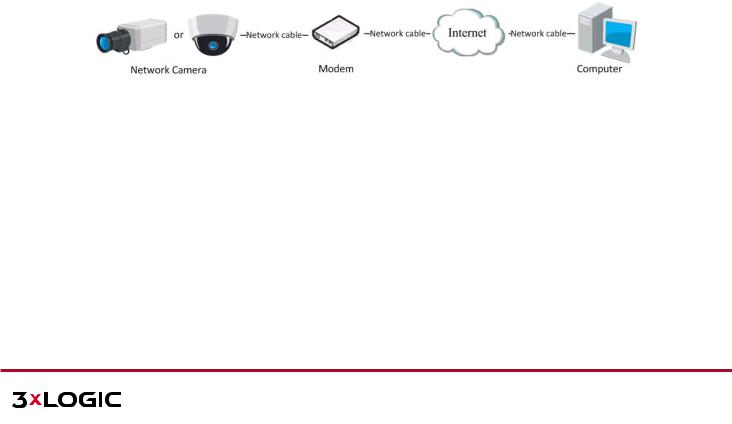
User Manual| VISIX Network Camera
DYNAMIC IP CONNECTION
Before you start:
Please apply a dynamic IP from an ISP. With the dynamic IP address, you can connect the network camera to a modem or a router.
Connecting the network camera via a router
Steps:
1)Connect the network camera to the router.
2)In the camera, assign a LAN IP address, the subnet mask and the gateway. Refer to Section 2.1.2 Detecting and Changing the IP Address for detailed LAN configuration.
3)In the router, set the PPPoE user name, password and confirm the password.
4)Set port mapping. E.g. 80, 8000, and 554 ports. The steps for port mapping vary depending on different routers. Please call the router manufacturer for assistance with port mapping.
NOTE: Refer to Appendix 2 for detailed information about port mapping.
5)Apply a domain name from a domain name provider.
6)Configure the DDNS settings in the setting interface of the router.
7)Visit the camera via the applied domain name.
Connecting the network camera via a modem
Purpose:
This camera supports the PPPoE auto dial-up function. The camera gets a public IP address by ADSL dial-up after the camera is connected to a modem. You need to configure the PPPoE parameters of the network camera. Refer to Section 5.3.3 Configuring PPPoE Settings for detailed configuration.
Figure 2-6 Accessing the Camera with Dynamic IP
NOTES: The obtained IP address is dynamically assigned via PPPoE, so the IP address always changes after rebooting the camera. To solve the inconvenience of the dynamic IP, you need to get a domain name from the DDNS provider (E.g. DynDns.com). Please follow the steps below for normal domain name resolution and private domain name resolution to solve the problem.
10225 Westmoor Drive, Suite 300, Westminster, CO 80021 | www.3xlogic.com | (877) 3XLOGIC |
14 |
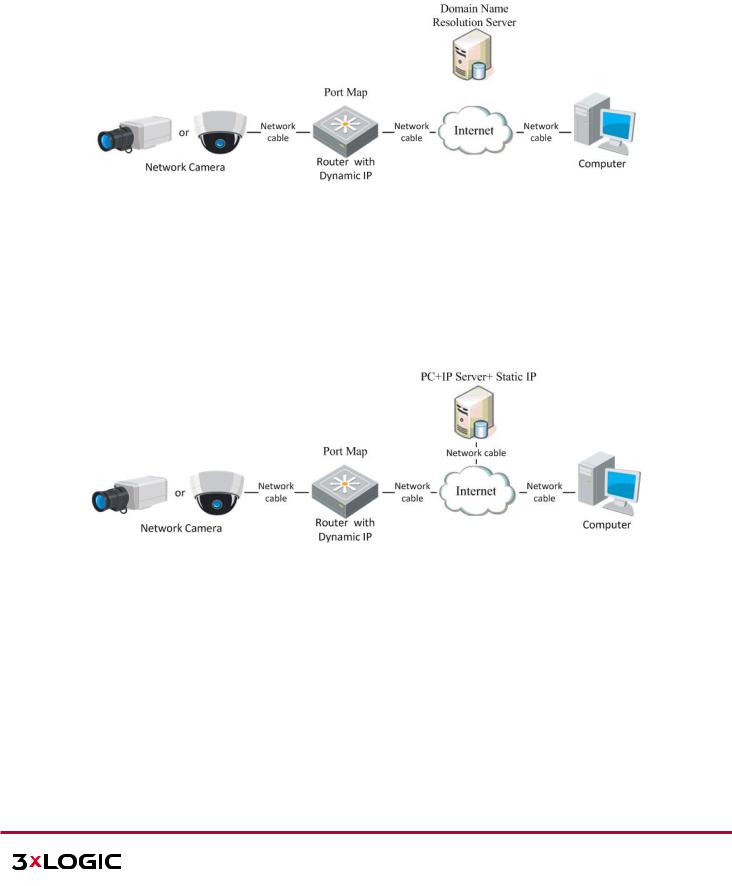
User Manual| VISIX Network Camera
Normal Domain Name Resolution
Figure 2-7 Normal Domain Name Resolution
Steps:
1)Apply a domain name from a domain name provider.
2)Configure the DDNS settings in the DDNS Settings interface of the network camera. Refer to Section 5.3.4 Configuring DDNS Settings for detailed configuration.
3)Visit the camera via the applied domain name.
Private Domain Name Resolution
Figure 2-8 Private Domain Name Resolution
Steps:
1)Install and run the IP Server software in a computer with a static IP.
2)Access the network camera through the LAN with a web browser or the client software.
3)Enable DDNS and select IP Server as the protocol type. Refer to Section 5.3.4 Configuring DDNS Settings for detailed configuration.
10225 Westmoor Drive, Suite 300, Westminster, CO 80021 | www.3xlogic.com | (877) 3XLOGIC |
15 |
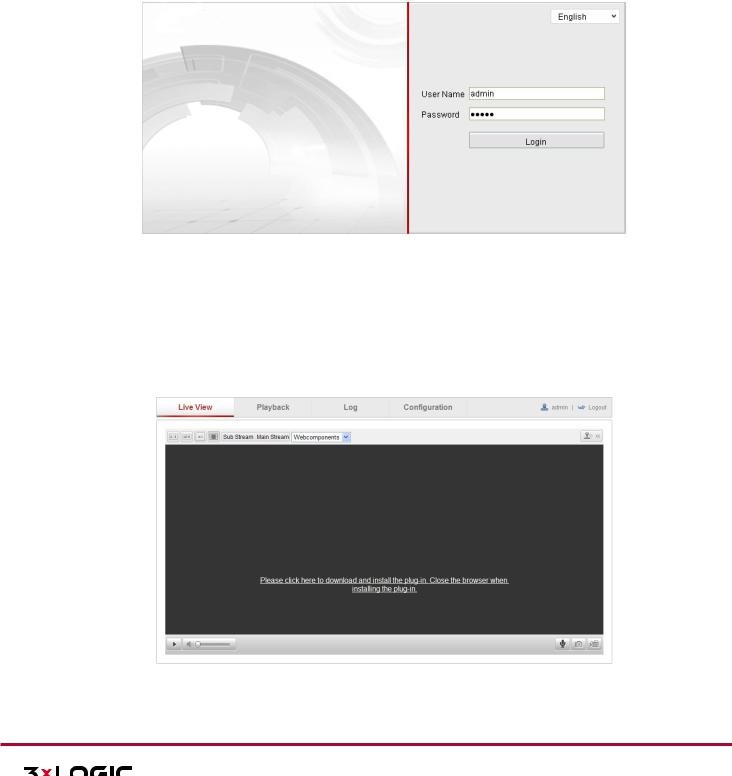
User Manual| VISIX Network Camera
3Access to the Network Camera
3.1 Accessing by Web Browsers
Steps:
1)Open the web browser.
2)Input the IP address of the network camera in the address bar, e.g., 192.0.0.64 and press the Enter key to enter the login interface.
3)Input the user name and password and click Login.
|
|
Figure 3-1 Login Interface |
|
! |
The default user name is admin, and the default password is 12345. |
Notes: |
! |
Multi-language is supported. English, Simplified Chinese, Traditional Chinese, Russian, |
|
|
Turkish, Japanese, Korean, Thai, Vietnamese, Estonian, Bulgarian, Hungarian, Czech, Slovak, |
|
|
French, Italian, German, Spanish, Portuguese, Polish, Greek, Dutch, etc. |
4)Install the plug-in before viewing the live video and operating the camera. Please follow the installation prompts to install the plug-in.
Figure 3-2 Download and Install Plug-in
10225 Westmoor Drive, Suite 300, Westminster, CO 80021 | www.3xlogic.com | (877) 3XLOGIC |
16 |
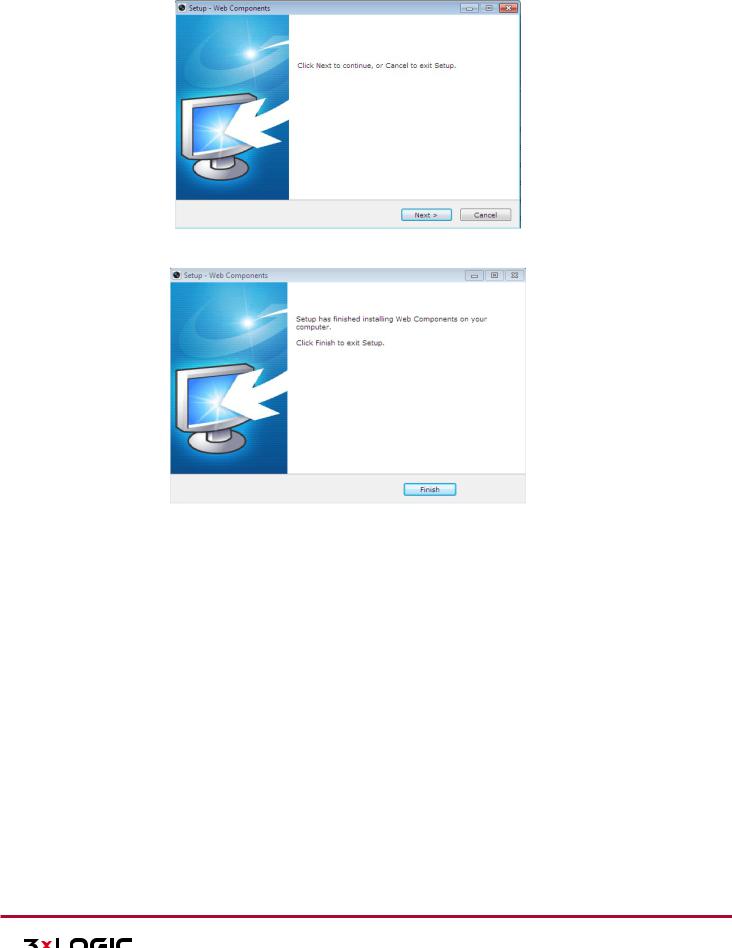
User Manual| VISIX Network Camera
Figure 3-3 Install Plug-in (1)
Figure 3-4 Install Plug-in (2)
Note: You may have to close the web browser to install the plug-in. Please reopen the web browser and log in again after installing the plug-in.
10225 Westmoor Drive, Suite 300, Westminster, CO 80021 | www.3xlogic.com | (877) 3XLOGIC |
17 |

User Manual| VISIX Network Camera
4 Wi-Fi Settings
Purpose:
By connecting to the wireless network, you don’t need to use cable of any kind for network connection, which is very convenient for the actual surveillance application.
Note: This chapter is only applicable for the cameras with the built-in Wi-Fi module.
4.1 Configuring Wi-Fi Connection in Manage and Ad-hoc Modes
Before you start:
A wireless network must be configured.
Wireless Connection in Manage Mode
Steps:
1) Enter the Wi-Fi configuration interface.
Configuration> Advanced Configuration> Network> Wi-Fi
Figure 4-1 Wireless Network List
2)Click Search to search the online wireless connections.
3)Click to choose a wireless connection on the list.
Figure 4-2 Wi-Fi SettingManage Mode
4)Check the checkbox to select the Network mode as Manage, and the Security mode of the network is automatically shown when you select the wireless network, please don’t change it manually.
Note: These parameters are exactly identical with those of the router.
5)Enter the key to connect the wireless network. The key should be that of the wireless network connection you set on the router.
Wireless Connection in Ad-hoc Mode
If you choose the Ad-hoc mode, you don’t need to connect the wireless camera via a router. The scenario is the same as you connect the camera and the PC directly with a network cable.
Steps:
1)Choose Ad-hoc mode.
10225 Westmoor Drive, Suite 300, Westminster, CO 80021 | www.3xlogic.com | (877) 3XLOGIC |
18 |

User Manual| VISIX Network Camera
Figure 4-3 Wi-Fi Setting- Ad-hoc
2)Customize a SSID for the camera.
3)Choose the Security Mode of the wireless connection.
Figure 4-4 Security Mode- Ad-hoc Mode
4)Enable the wireless connection function for your PC.
5)On the PC side, search the network and you can see the SSID of the camera listed.
Figure 4-5 Ad-hoc Connection Point 6) Choose the SSID and connect.
SECURITY MODE DESCRIPTION:
Figure 4-6 Security Mode
You can choose the Security Mode as not-encrypted, WEP, WPA-personal, WPA-enterprise, WPA2-personal, and WPA2-enterprise. WEP mode:
10225 Westmoor Drive, Suite 300, Westminster, CO 80021 | www.3xlogic.com | (877) 3XLOGIC |
19 |

User Manual| VISIX Network Camera
Figure 4-7 WEP Mode
!Authentication - Select Open or Shared Key System Authentication, depending on the method used by your access point. Not all access points have this option, in which case they probably use Open System, which is sometimes known as SSID Authentication.
!Key length - This sets the length of the key used for the wireless encryption, 64 or 128 bit. The encryption key length can sometimes be shown as 40/64 and 104/128.
!Key type - The key types available depend on the access point being used. The following options are available:
!HEX - Allows you to manually enter the hex key.
!ASCII - In this method the string must be exactly 5 characters for 64-bit WEP and 13 characters for 128bit WEP.
WPA-personal and WPA2-personal Mode:
Enter the required Pre-shared Key for the access point, which can be a hexadecimal number or a passphrase.
Figure 4-8 Security Mode
WPA-personal WPAenterprise and WPA2-enterprise Mode:
Choose the type of client/server authentication being used by the access point;
EAP-TLS or EAP-PEAP.
10225 Westmoor Drive, Suite 300, Westminster, CO 80021 | www.3xlogic.com | (877) 3XLOGIC |
20 |

User Manual| VISIX Network Camera
EAP-TLS
Figure 4-9 EAP-TLS
!Identity - Enter the user ID to present to the network.
!Private key password – Enter the password for your user ID.
!EAPOL version - Select the version used (1 or 2) in your access point.
!CA Certificates - Upload a CA certificate to present to the access point for authentication. EAP-PEAP:
!User Name - Enter the user name to present to the network
!Password - Enter the password of the network
!PEAP Version - Select the PEAP version used at the access point.
!Label - Select the label used by the access point.
!EAPOL Version - Select version (1 or 2) depending on the version used at the access point
!CA Certificates - Upload a CA certificate to present to the access point for authentication
4.2 Easy Wi-Fi Connection with WPS function
Purpose:
The setting of the wireless network connection is never easy. To avoid the complex setting of the wireless connection you can enable the WPS function.
WPS (Wi-Fi Protected Setup) refers to the easy configuration of the encrypted connection between the device and the wireless router. The WPS makes it easy to add new devices to an existing network without entering long passphrases. There are two modes of the WPS connection, the PBC mode and the PIN mode.
Note: If you enable the WPS function, you do not need to configure the parameters such as the encryption type and you don’t need to know the key of the wireless connection.
Steps:
10225 Westmoor Drive, Suite 300, Westminster, CO 80021 | www.3xlogic.com | (877) 3XLOGIC |
21 |
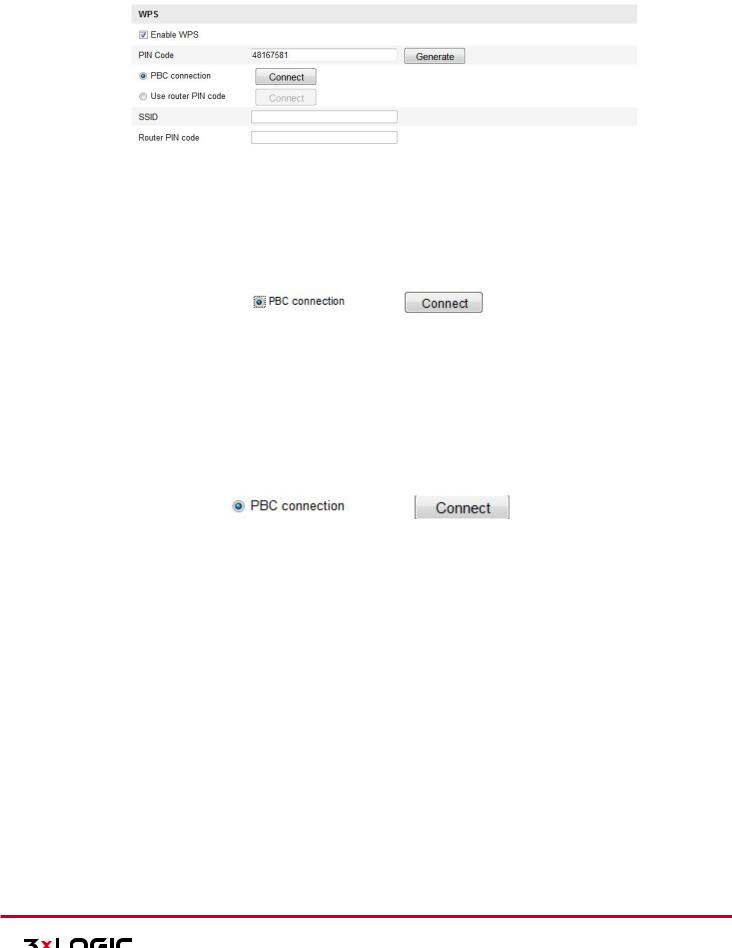
User Manual| VISIX Network Camera
Figure 4-10 Wi-Fi Settings - WPS PBC Mode:
PBC refers to the Push-Button-Configuration, in which the user simply has to push a button, either an actual or
virtual one (as the  button on the configuration interface of the IE browser), on both the Access Point (and a registrar of the network) and the new wireless client device.
button on the configuration interface of the IE browser), on both the Access Point (and a registrar of the network) and the new wireless client device.
1)Check the checkbox of  to enable WPS.
to enable WPS.
2)Choose the connection mode as PBC.
Note: Support of this mode is mandatory for both the Access Points and the connecting devices.
3)Check on the Wi-Fi router to see if there is a WPS button. If yes push the button and you can see the indicator near the button start flashing, which means the WPS function of the router is enabled. For detailed operation, please see the user guide of the router.
4)Push the WPS button to enable the function on the camera.
If there is not a WPS button on the camera, you can also click the virtual button to enable the PBC function on the web interface.
5)Click Connect button.
When the PBC mode is both enabled in the router and the camera, the camera and the wireless network is connected automatically.
PIN Mode:
The PIN mode requires a Personal Identification Number (PIN) to be read from either a sticker or the display on the new wireless device. This PIN must then be entered to connect the network, usually the Access Point of the network.
Steps:
1)Choose a wireless connection on the list and the SSID is shown.
10225 Westmoor Drive, Suite 300, Westminster, CO 80021 | www.3xlogic.com | (877) 3XLOGIC |
22 |
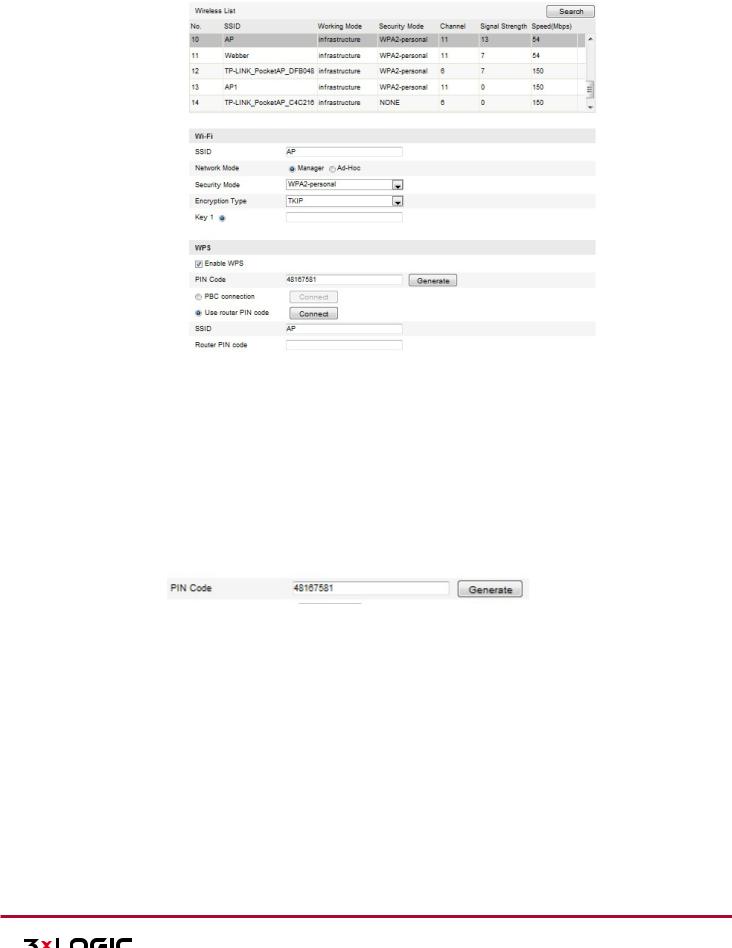
User Manual| VISIX Network Camera
Figure 4-11 Wi-Fi Settings – WPS PIN Mode
2)Choose Use route PIN code.
If the PIN code is generated from the router side, you should enter the PIN code you get from the router side in the Router PIN code field.
3)Click Connect.
Or
You can generate the PIN code on the camera side. And the expired time for the PIN code is 120 seconds. 1. Click Generate.
4)Enter the code to the router, in the example, enter 48167581 to the router.
4.3 IP Property Settings for Wireless Network Connection
The default IP address of wireless network interface controller is 192.168.1.64. When you connect the wireless network you can change the default IP.
Steps:
1)Enter the TCP/IP configuration interface.
Configuration> Advanced Configuration> Network> TCP/IP or
Configuration> Basic Configuration> Network> TCP/IP
10225 Westmoor Drive, Suite 300, Westminster, CO 80021 | www.3xlogic.com | (877) 3XLOGIC |
23 |

User Manual| VISIX Network Camera
Figure 4-12 TCP/IP Settings
2)Select the NIC as wlan.
3)Customize the IPv4 address, the IPv4 Subnet Mask and the Default Gateway. The setting procedure is the same with that of LAN.
If you want to be assigned the IP address you can check the checkbox to enable the DHCP.
10225 Westmoor Drive, Suite 300, Westminster, CO 80021 | www.3xlogic.com | (877) 3XLOGIC |
24 |
